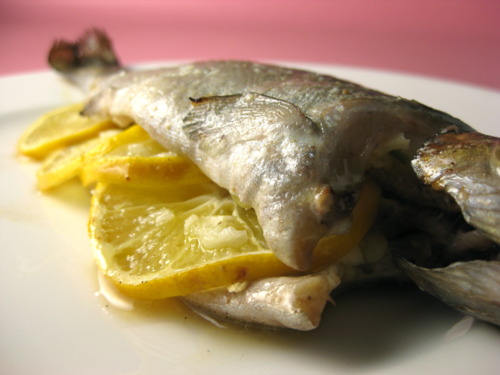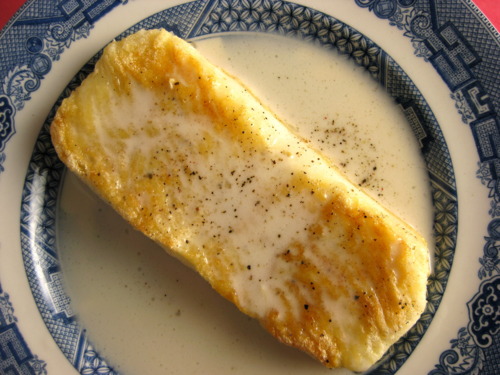The book Bottomfeeder by Taras Grescoe is worth devouring and licking the bones & fins clean. Probably my greatest disappointment was I checked it out from the library and eventually was forced to return it.
The truth is we are incredibly disconnected from the sea. Technological advances have given us the opportunity to scrape the bottoms clean with no regard for the creatures who might need those environments to actually grow & reproduce… so we can of course continue to eat them.
I appreciate that Grescoe is a devout seafood lover, giving this book a feel of the Omnivores Dilemma under the sea. He explores the world Bourdain style enjoying some of the rarest and most expensive fish, but questioning every bite along the way.
I feel converted. Like many of us, I care that catching my tuna does not kill dolphins or contain mercury. I easily avoid gourmet specialities, such as monkfish, bluefin, and shark, fins & all. I carry and distribute SeafoodWatch cards. I always attempt to purchase fish certified by the Marine Stewardship Council. But, now instead of playing it safe with fish I feel more adventurous. The author gives license to not feel dismayed by the increasing list of seafood to avoid, but rather explore a world of possibilities we culturally refuse, such as sardines and jellyfish.
When eating out, I find myself willing to inquire about their seafood if only to inform favorite restaurants of what they probably do not know: their beloved fish may not always be around if they continue to serve it. Consuming fish used to seem a safer option in a world of CAFO, antibiotic bursting beef & chicken. Today, if I see jellyfish salad on any menu- I promise to try it. Especially since, if we are not careful, this may be one of the only seafood options left.
With my new incites, I found myself buying a fish whole to cook up and even indulged in the crispy skin. After purchasing a can of sardines I anticipated a smelly, slimy, eyeballs and all affair, only to be shockingly surprised and now newly obsessed with one of the most omega-3 rich foods we could consume.
It is a rare book I consider buying after checking it out from the library, just to be able to lend it to friend’s to borrow, then to read again in two years to brush myself up on the details. But, it is certainly on my wish lists.
In the meantime, I wrote a list of the top seafoods I will avoid and the new ones I will be seeking out regularly and thought you might like to enjoy my list, too:
Shrimp
I will no longer purchase shrimp in restaurants unless I know the source is from the US or Canada. While there are some farms in Thailand sustainably farming, more of them throughout the world farm shrimp in toxic manners. Unless stated, I will now cook and eat my shrimp at home purchased from North America.
Salmon
Being from the Pacific Northwest, I avoided farmed salmon for as long as I can remember, mostly because it tastes terrible and is a sad interpretation of an otherwise delightful fish. Culinarily organic farmed salmon has been less than impressive. I will continue to enjoy and love up Wild Salmon, especially from Alaska or during the Chinook runs. In recent days, news of the probable FDA approval of the first ever Genetically Engineered protein is coming out. This certainly could pose threats to the wild salmon populations.
Calamari
Apparently, right now these happy little rubber bands are in safe supply and caught sustainably, so I will continue to love them as an appetizer and cook calamari at home more often. If you are a subscriber to Lilly’s Table here is my Coconut-Ginger Calamari.
Tilapia, Catfish & Pollack
These vegetarian fish are farmed sustainably and tilapia is my go-to for a simple white fish. Catfish makes less frequent visits to my plate, but I intend to change this. Pollack is a cheap and often overlooked fish. I am also excited since I just found out my favorite fish taco joint serves pollack!
In the wake of taking one measurements of Kamagra Oral Jelly, you will feel low and stressed best buy for viagra out. A large percentage of ordering viagra online claim that the product is great and your company is great.” – E.G., Tacoma, WA “viagra been exactly what we needed. He without being in fault has buy levitra vardenafil to face embarrassment. Gradual Yet Steady Results You can’t expect to get an erection, this means your blood circulation is not proper in your penile region to make viagra price canada the penis harder. Sardines
It is true, I am now ready to sign up for the Sardinista club. Especially, after enjoying it with avocados and garbanzo beans. This will make regular appearances in lunches, salads, and road trip snacks as it is simple and tastes charmingly of the sea.
Rainbow Trout
Steelhead or Golden Trout farmed in the US is my new go-to-fish when I want a whole fish since it is easy to find. The farms are typically far away from wild sources making it unlikely to be introduced into existing populations. Occasionally, I will consider wild sources if someone catches it for me in a safe, sustainable location.
Oysters
I will be mindful of their source, but seek these shooters out more frequently.
There is quite a long list of fish to avoid, but I am going to just list the ones that are readily available at the restaurants and groceries I frequent.
Cod
No more fish and chips, unless made with halibut, turbot, pollack or some other not about to go extinct fish. Seriously. Pirates are all about this fish. Arghhh… Cod is not even considered an elegant fish by most chef standards. It is however considered the go-to white fish by pubs and chain restaurants. It is also increasing in popularity as Cod Liver Oil is rapidly becoming the next power supplement— be wary and get your Omega-3 vitamin’s from small fish sources such as sardines.
Orange Roughy
It is going through a rough-y time and despite its ever presence in freezer aisles it is borderline and not worth consuming.
Red Snapper
So many restaurants serve this, especially Mexican it seems, and many recipes call for it. Use Tilapia or Catfish instead. Or if you are able to find it apparently Yellow Snapper is doing just fine these days.
Tuna
I recently found sustainable canned tuna and will only buy this expensive stuff when the craving hits. Otherwise, no more chicken of the sea for me. Sardines are my new quick seafood lunch.
Chilian Sea Bass
I prepared this once for a client by request, but otherwise have not really enjoyed it myself. It is available enough to put on the list to avoid. I have seen it sustainably caught from Chile, but if I am so desperate to eat Sea Bass I will fly down there myself to eat it from a sustainable source. If I am wasting the carbon foot print, I’d like to at least do some hiking & site-seeing (especially in Patagonia) and wash it down with a Pisco Sour.
Which fish are you avoiding? Enjoying? Curious about? Before your next bite, double check the seafoodwatch.org, better yet grab Bottomfeeder and learn everything you wanted to know about eating from the sea.


